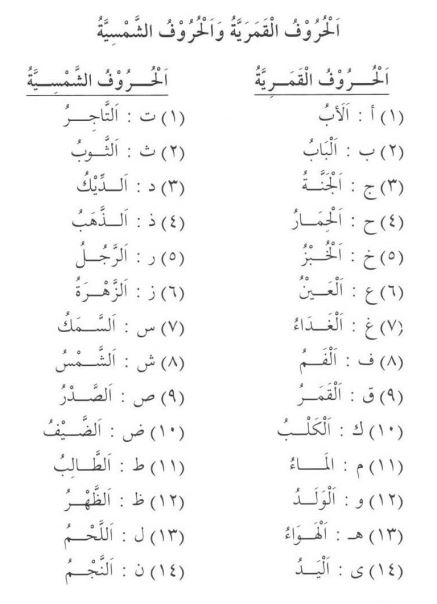Durus al-Lughah Book 1 Lesson 3 : Ism ma'rifah | Jumlah Ismiyyah
Have you finished studying Durus al-lughah al-arabiyyah Volume 1 Lesson 2? Once you finish that lesson, let's learn lesson 3.
What will you learn in chapter/lesson 3? You will learn the following things:
1. Definite noun and indefinite noun in Arabic.
2. Nominal sentence in Arabic.
3. Solar letters and lunar letters in Arabic.
Definite noun (اسم معرفة) and indefinite noun (اسم نكرة)
 |
| Types of noun in terms of definiteness |
 |
| Ism nakirah (indefinite noun) and ism ma'rifah (definite noun) |
 |
| Nominal sentence (jumlah ismiyyah) examples |
Lesson Summary
From the picture, we learn the following things:
1. There are two types of noun in terms of definiteness, they are a definite noun and indefinite noun.
2. Definite noun in Arabic is called اسم معرفة (ism ma'rifah)
3. Indefinite noun in Arabic is called اسم نكرة (ism nakirah)
4. Indefinite noun (اسم نكرة):
a. There is a tanwiin at the final letter
b. Example : baytun (بَيْتٌ) = a house
5. Definite noun (اسم معرفة)
a. There is a prefix definite article "ال"
b. Definite article ال is called harf ta'rif (حرف تعريف)
c. There is no tanwiin at the final letter
d. Example: al-baytu (البَيْتُ)
6. Making a simple sentence in Arabic which begins with a noun:
a. The sentence begins with definite noun (ism ma'rifah).
This first part is called mubtada' (مبتدأ)
b. The second part can be indefinite noun, shibhul jumlah, or jumlah.
But, in chapter 3, we focus on an indefinite noun.
This part is called khabar (خبر)
c. There are agreements between mubtada' and khabar in terms of:
— number : mubtada and khabar must have the same number, such as: singular, dual, or plural.
In this chapter, we focus on singular noun.
— gender: mubtada and khabar must have the same gender, such as: masculine and feminine.
In this chapter, we focus on masculine noun.
— case: mubtada and khabar must have the same case, such as: nominative, accusative, or genitive.
In this chapter, we focus on nominative case (marfu').
Simple sentence with nominal sentence (jumlah ismiyyah) Examples
From the picture above, we learn these points:
1. We can make a simple sentence, begin with a noun.
The sentence which begins with a noun is called a nominal sentence.
Nominal sentence in Arabic is called jumlah ismiyyah (جملة اسميّة)
2. Jumlah ismiyyah contains two parts:
a. The first part is called mubtada' (مبتدأ)
b. The second one is called khabar (خبر)
3. Mubtada' must be ism ma'rifah (definite noun).
We can change ism nakirah (indefinite noun) form to definite form by prefixing harf ta'rif "ال", and the last letter is no tanwiin.
Example:
kitaabun (كِتَابٌ) => a book. This is an indefinite noun.
The definite noun form of كِتَابٌ is الكِتَابُ (al-kitaabu).
4. Khabar can be a noun (should be indefinite noun), shibhul jumlah (jar wa majrur, etc.), and jumlah (jumlah ismiyyah or jumlah fi'liyyah).
But, in this lesson, we focus on singular and masculine noun.
We will learn shibhul jumlah and jumlah as a khabar in the next lesson, in shaa Allah.
5. al-kitaabu jadiidun (الكِتَابُ جَدِيْدٌ) is an example of jumlah ismiyyah (nominal sentence).
- al-kitaabu (الكِتَابُ): mubtada'
- jadiidun (جَدِيْدٌ): khabar
6. There is an agreement between mubtada' and khabar in terms of number, gender, and case.
al-kitaabu jadiidun (الكِتَابُ جَدِيْدٌ)
— al-kitaabu: singular noun, masculine noun, nominative case.
— jadiidun: singular noun, masculine noun nominative case.
Huruf ash-shamsiyyah (solar letters) & huruf al-qamariyyah (lunar letter)
From the picture above, the points are:
1. There are two types of letter in Arabic, they are: solar letters and lunar letters.
2. Arabic has 28 letters. 14 letters are solar letters, and 14 letters are lunar letters.
We can see all the letters in the picture above.
3. Solar letter (الحروف الشّمسيّة) rules in terms of prefix "ال" :
When "al" is prefixed to a noun beginning with a solar letter the "l" of "al" is assimilated to the solar letter.
Example:
نَجْمٌ (najmun) = a star.
النَّجْمٌ (an-najmun) = the star.
From al-najmu becomes an-najmu.
4. lunar letter (الحروف القمريّة) rules in terms of prefix al (ال): no assimilation takes place with the lunar letters.
Example:
qamarun (قَمَرٌ ) becomes al-qamaru (القَمَرُ )
Arabic vocabulary within this lesson
Arabic words with English meaning.
- مَكْسُورٌ = broken
- مَفْتُوْحٌ = open
- جَالِسٌ = sitting
- وَاقِفٌ = standing
- جَدِيْدٌ = new
- قَدِيْمٌ = old
- صَغِيْرٌ = small
- كَبِيْرٌ = big
- وَسِخٌ = dirty
- المَاءُ = the water
- بَارِدٌ = cold
- القَمَرُ = the moon
- جَمِيْلٌ = beautiful
- قَرِيْبٌ = near
- بَعِيْدٌ = far
- ثَقِيْلٌ = heavy
- خَفِيْفٌ = light
- الوَرَقُ = the paper
- حَارٌّ = hot
- نَظِيْفٌ = clean
- نَجْمٌ = a star
- السُّكَّرُ = the sugar
- حُلْوٌ = sweet
- مَرِيضٌ = sick
- الدَّفْتَرُ = the book (book for taking notes)
- غَنِيٌّ = rich
- الدُّكَّانُ = the shop
- فَقِيْرٌ = poor
- التُّفَّاحُ = the apple
- لَذِيْذٌ = delicious
- طَوِيْلٌ = tall
- قَصِيْرٌ = short
- الأَبُ = the father
- الجَنَّةُ = heaven
- العَيْنُ = the eye
- الغَدَاءُ = lunch
- الفَمُ = mouth
- الهَوَاءُ = the air
- اليَدُ = hand
- الثَّوبُ = clothing
- الذَّهَبُ = gold
- الزَّهْرَةُ = the flower
- السَّمَكُ = the fish
- الشَّمْسُ = the sun
- الصَّدْرُ = chest
- الضَّيْفُ = guest
- الظَّهْرُ = back (rear part of human boy)
- اللَّحْمُ = meat
- الأَخُ = the brother
- الرَّسُولُ = the messenger (the prophet)
- الوَجْهُ = the face
- الصَّدِيْقُ = the friend
- الرَّأْسُ = the head
- الإصْبَعُ = the finger
- الصَّبُوْنُ = the soap
- الظُّفْرُ = the nail
- الفَجْرُ = dawn
- الظُّهْرُ = midday
- العَصْرُ = afternoon
- المَغْرِبُ = sunset time
- العِشَاءُ = evening
Do you want an e-book PDF version of this lesson, so that you can print out and start reading, understanding, and memorizing the vocabulary?
If you want to get the PDF version, feel free to submit your email in the form below. The file will directly send to you via your email.
Continue to lesson 4 : huruuf al-jarr




No comments:
Post a Comment